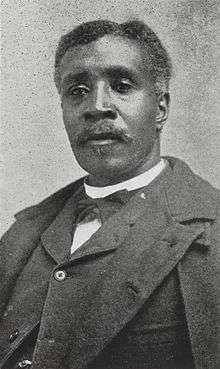William Washington Browne
| William Washington Browne | |
|---|---|
 Portrait photograph of William Washington Browne | |
| Born |
Ben Browne October 20, 1849 Habersham County, Georgia |
| Died |
December 21, 1897 (aged 48) Washington, D.C. |
| Spouse(s) | Mary A. Graham |
William Washington Browne (October 20, 1849 – December 21, 1897) was a former slave, Union soldier, and the founder of the Grand Fountain of the United Order of True Reformers, also known as the Grand United Order of True Reformers.[1][2] Browne was also a minister and a teacher.
Personal life
Browne was born into slavery as Ben Browne in Habersham County, Georgia on October 20, 1849 to Joseph Browne and Mariah Browne, both of whom were slaves.[3] He was sold to a horse trader around age eight and after this sale Browne changed his name to William Washington.[4] Browne escaped his owners during the Civil War and joined the Union army, where he remained until he was discharged from service in 1862. After discharge Browne attended school in Wisconsin and began a teaching position in the South, during which time he met and married his wife Mary A. Graham.[5]
He was an outspoken proponent of the temperance movement and was equally outspoken against the Ku Klux Klan.[6] Brown initially sought to join the Independent Order of Good Templars, but was denied membership because the society was traditionally white. The society did offer Browne the option of opening a sponsored charter named the Grand United Order of True Reformers, which he accepted.[5]
Browne died in Washington D.C. December 21, 1897 due to cancer and was buried in Sycamore Cemetery.
Grand United Order of True Reformers
The Grand United Order of True Reformers started as a temperance organization and in 1876 Browne was invited to spearhead a new branch of the movement in Richmond, Virginia.[5] When interest in the organization began to decrease Browne began shifting the organization from a temperance society to an insurance organization, a movement that required Browne to move to Richmond in 1880.[4] Over time the organization grew in size to where it managed a bank, ran a newspaper entitled the Reformer, owned several properties, and at one point in time was the largest black fraternal society and black-owned business in the United States.[4][7]
During Browne's life the organization enjoyed success, however it suffered crippling setbacks in 1910 due to employee embezzlement and businesses defaulting on large unsecured loans, causing its collapse.[8]
Further reading
- Burrell, William Patrick (1909). Twenty-five Years History of the Grand Fountain of the United Order of True Reformers.
See also
References
- ↑ Watkinson, James D. (July 1989). "William Washington Browne and the True Reformers of Richmond, Virginia". The Virginia Magazine of History and Biography 97 (3): 375–398. Retrieved 10 August 2015.
- ↑ Ingham, John N.; Feldman, Lynne B. (1993). African-American Business Leaders: A Biographical Dictionary. Greenwood Publishing Group. pp. 112–120. ISBN 9780313272530. Retrieved 10 August 2015.
- ↑ Mjagkij, Nina (2003). Portraits of African American Life Since 1865. Rowman & Littlefield. pp. 35–49. ISBN 9780842029674. Retrieved 10 August 2015.
- 1 2 3 Watkinson, James D. "William Washington Browne (1849–1897)". Encyclopedia Virginia. Retrieved 10 August 2015.
- 1 2 3 Williams, Michael Paul. "William Washington Browne". Richmond Times Dispatch. Retrieved 10 August 2015.
- ↑ Kranz, Rachel (2004). African-American Business Leaders and Entrepreneurs. Facts on File. pp. 34–35. ISBN 0816051011. Retrieved 10 August 2015.
- ↑ Mjagkij, Nina (2001). Organizing Black America. Routledge. p. 220. ISBN 0815323093. Retrieved 10 August 2015.
- ↑ Fahey, David M. (2013). "Why some black lodges prospered and others failed: the Good Templars and the True Reformers". Ethnic and Racial Studies 36 (2): 337–352. doi:10.1080/01419870.2012.676196. Retrieved 10 August 2015.
External links
- Celebrating Black History Month, Part II: Reconstruction at the National Endowment for the Humanities
- Grand Fountain of the United Order of True Reformers at Encyclopedia Virginia